With coastal areas, waterfalls, and miles and miles of forests, South Carolina is the home and haven for many Avian species and consequently, a great place for birding! Today we are going to talk about birding in the Palmetto state. We’ll tell you about the local birds, including when to look for them, what to look for, dietary preferences, and more! Without further ado, let’s talk about the popular backyard birds of South Carolina!
3 Categories – 480 Birds
South Carolina is home to an impressive 480+ species of bird. This is enough to keep a birdwatcher very, very busy and it’s certainly too many birds for us to list here. This means we will have to settle for giving you a sampling of birds and to keep things organized we will divide them up into the seasons when you should look for them. We will sort them in these categories:
- Year-round Resident birds
- Birds of Spring, Summer, and Early Fall
- Fall and Winter Birds
After this you’ll have a collection of birds to look for year-round but we’ll give you a little more than that, such as feeding advice and where these birds like to go when they aren’t gracing your backyard. Let’s get started with our year-round resident birds!
South Carolina’s Year-Round Resident Birds
These birds love South Carolina dearly and to show it, they can be spotted at any time of the year. It doesn’t matter if it’s warm or cold, the birds which we have listed below feel right at home and are patiently waiting to see if you can spot them. Keep your eyes peeled for the following year-round resident birds of South Carolina:
- Carolina Chickadee
- Carolina Wren
- Red-bellied Woodpecker
- Tufted Titmouse
- Northern Cardinal
Carolina Chickadee – Poecile carolinensis
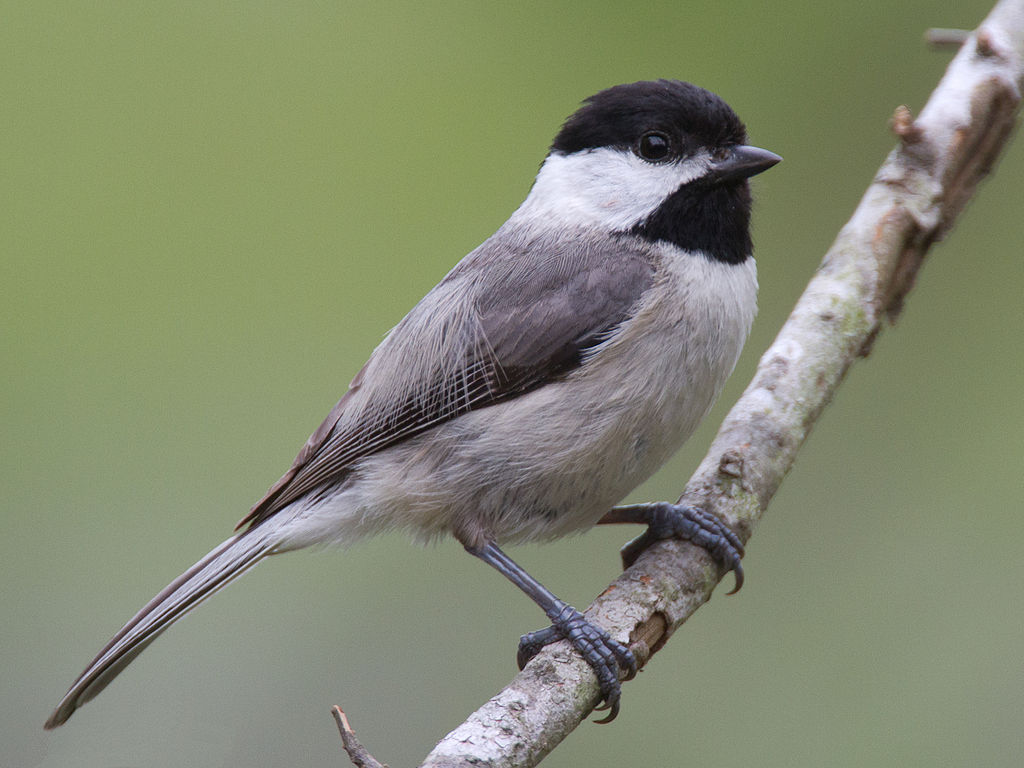
Coloration and Markings: Carolina Chickadees have gray wings and small, fanning gray tails. They have a white breast and underbelly and facially, the center of the head is the same white as the breast and they have a black bib from bill to throat and a large, black cap which takes up the upper portion of the head and stops at the middle of the eyes.
Size: These are small birds, measuring in at a mere 3.9 – 4.7 inches in length with wingspans of 5.9 to 7.9 inches.
Habitat: Just about any forest area may be home to these birds and they also frequently visit parks and backyards, especially if large trees are present.
Diet: Carolina Chickadees don’t need anything complicated. They love crushed peanuts, suet, and Black Oil Sunflower seeds and will come back for more once they’ve noticed that you have them.
Carolina Wren – Thryothorus ludovicianus

Coloration and Markings: Carolina Wrens have light to chestnut brown backs, wings, and medium-sized tails with a checkered black and white edging on the wing and tailfeathers. They have a light yellow-orange breast and underbelly and facially this bird has a small white bib and as well as some white just before the neck and a large, white eyebrow mark. Just under the eye the face is white with black dotting and just behind the eye is a brown line which travels to the back of the head. The top of the bird’s head is brown and it has a long, slightly curved black bill.
Size: These birds measure in at 4.7 – 5.5 inches in length with a wingspan of approximately 11.4 inches.
Habitat: These birds love brambles, thickets, and shrubs for the safety which they provide when it comes to foraging. They will visit backyard feeders and if you have some brush or bushes then this increases your chances of a visit.
Diet: Those these birds make up most of their diet with insects they also enjoy seeds and berries. Try some chopped strawberries or cherries with Black Oil Sunflower seeds and you might just lure in a Carolina Wren.
Red-bellied Woodpecker – Melanerpes carolinus

Coloration and Markings: Red-bellied Woodpeckers have zebra-striped backs, wings, and medium-sized tails. They have a white breast and their underbelly has some black peppering present. When the bird is close you will notice that faint red splotches are present on the breast as well. Facially, these birds have white faces with some faded red and striking red caps which goes down the neck to just above the shoulders and they have long, straight black bills.
Size: These birds measure in at approximately 9.4 inches in length from head to tail and have wingspans of 13 to 16.5 inches.
Habitat: These birds spend time in the deep woods, especially around hardwoods such as Hickory or Oak. They venture forth often, however, and are frequent visitors to feeders if you have left out something that they like.
Diet: Black Oil Sunflower seeds, suet, and peanuts are all favorites of this bird and will keep them coming back for more.
Tufted Titmouse – Baeolophus bicolor
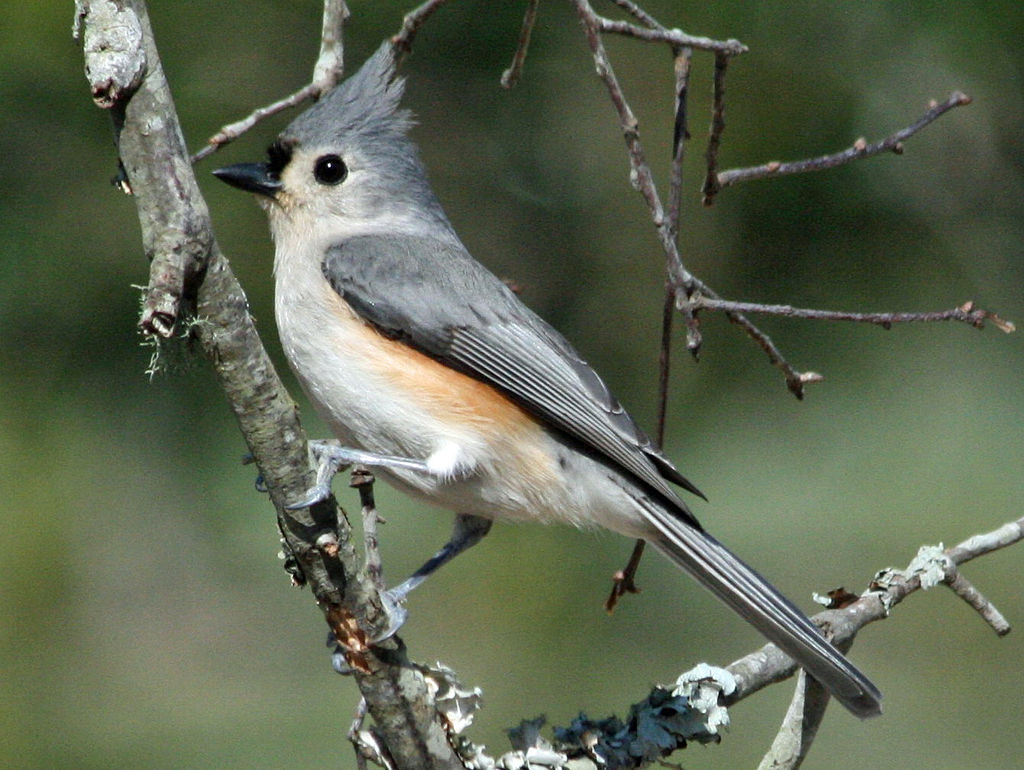
Coloration and Markings: The Tufted Titmouse have blue-gray back, wings, and a medium-sized tail with a white breast and underbelly. Just under the wings there are traces of peach coloration lightly flanking the white sides and facially these birds have mostly white faces with some blue coloration behind the eye down to cheek level and full gray-blue coloration above the eye. They have lovely small crests and a distinctive black square above a tiny, slightly curved black bill.
Size: These birds measure in at 5.5 – 6.3 inches in length with a wingspan of 7.9 to 10.2 inches.
Habitat: These birds like Evergreen and deciduous forests, but often venture out to visit orchards, parks, and backyard feeders.
Diet: These birds are easy to please. They enjoy suet, Black Oil Sunflower seeds, and peanuts.
Northern Cardinal – Cardinalis cardinalis
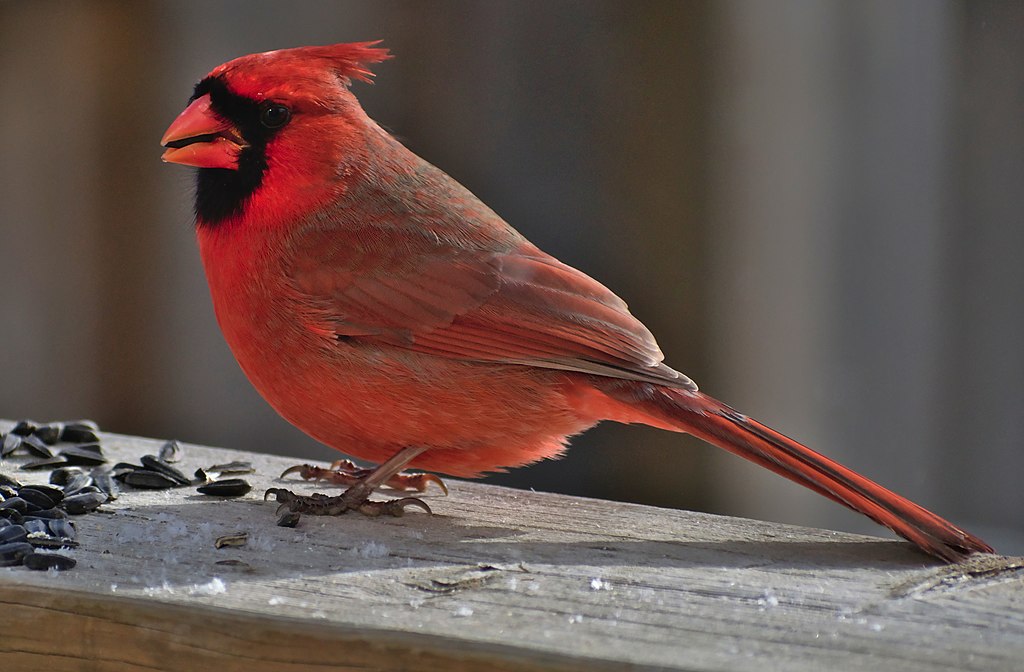
Coloration and Markings: The Northern Cardinal male is a striking red all over its body, from the tip of its tail to it’s glorious red crest. Occasionally you will see some gray in it’s plumage but beyond this the only changes in coloration are it’s black mask, which extends to the chin, and a stout, orange conical bill. Female Cardinals will be a soft brown all over, with some traces of red throughout the plumage, but are no less breathtaking. These are the kinds of birds that inspire new people to birdwatching every day!
Size: These birds measure in at 8.3 – 9.1 inches in length with wingspans of 9.8 to 12.2 inches.
Habitat: When they aren’t staying close to the forest’s edge, these birds frequently visit cities and towns. They are not shy about visiting backyard feeders as long as you have left out some thoughtful offerings, so be sure to stock up your feeders well in advance.
Diet: Northern Cardinals like a number of different foods, such as Safflower and Black Oil Sunflower seeds, White Proso millet, cracked corn, and crushed peanuts. They will also visit your berry vines so you can try leaving out berries or chopped apples if you see a Cardinal nearby.
South Carolina’s Birds of Spring, Summer, and Early Fall
Spring, summer, and fall are colorful times in South Carolina and certain birds are especially fond of them. This is a great time for the birds and a great time for you as well, since camping and hiking have suddenly become very good options for enjoying nature and getting a look at some new birds up-close and in their element. Watch for these birds during spring, summer, and early fall:
- Northern Mockingbird
- Swanson’s Thrush
- Scarlet Tanager
- Rose-breasted Grosbeak
- Indigo Bunting
Northern Mockingbird – Mimus polyglotto

Coloration and Markings: Northern Mockingbirds have gray backs, wings, and long, thin gray tails with white outer feathers. You will note that this bird has two distinctive wingbars as well and display an impressive white patch on each wing when in flight. Mockingbirds have a white breast and a white-gray underbellies and facially they are white at the chin to just over the bill and they have white cheeks, often lightly outlined in gray. The upper portion of this bird’s head is soft gray as well and these is often a black line going from the front of the eye to the short, slightly curved black bill.
Size: These birds measure in at 8.3 – 10.2 inches in length with wingspans of 12.2 to 13.8 inches.
Habitat: These birds spend their time at the forest’s edge or wandering around in parks or the suburbs. They will happily visit a well-stocked feeder.
Diet: Northern Mockingbirds primarily dine on insects but they do like fruit. Try some sliced oranges and apples for best results.
Swainson’s Thrush – Catharus ustulatus

Coloration and Markings: Swainson’s Thrush birds have brown or gray backs with the same coloration on their long wings and medium-sized tails. They have a white breast with black spots which become faded streaks as they descend to the white underbelly. Facially, this bird has gray spotting on a white chin and throat, with the rest of the face being a soft gray or brown. You will also notice a distinctive white or brownish yellow eyering. These birds have short, straight bills which are typically black or yellow with black tips.
Size: These birds measure in at 6.3 – 7.5 inches from tip to tail with wingspans of 11.4 to 12.2 inches.
Habitat: Coniferous and deciduous forests are the favorite haunts of the Swainson’s Thrush, but they will occasionally venture forth and visit suburban backyards.
Diet: These birds mostly eat insects but they appear to be partial to red fruits and berries. Try some chopped cherries and strawberries to see if this gets their attentions.
Scarlet Tanager – Piranga olivacea
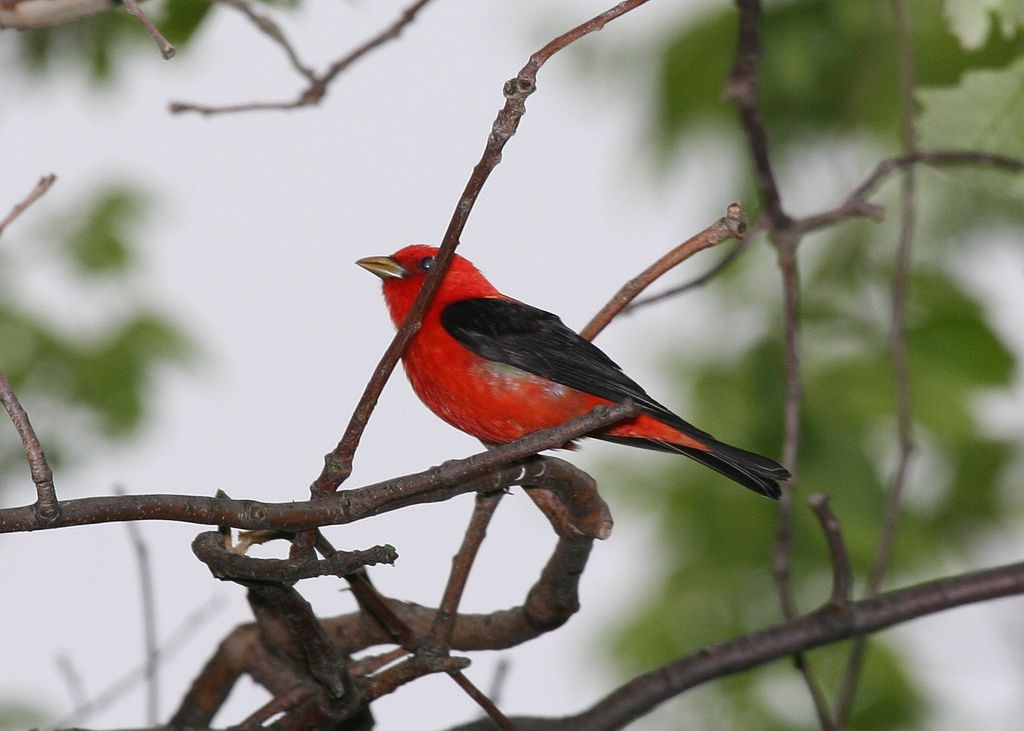
Coloration and Markings: Scarlet Tanagers are quite stunning and are one of those bird sightings that get your heart to beating quickly. The back, breast, and underbelly are a rich scarlet color while the wings and tiny forked tails are black. Sometimes a yellow marking is present at the shoulder but most often the wings are simply black. Facially, the scarlet coloration becomes slightly richer and this bird has a stout, medium-sized yellow bill.
Size: These birds measure in at 6.3 – 6.7 inches in length with wingspans of approximately 9.8 to 11.4 inches.
Habitat: These birds prefer to nest in Evergreen or deciduous forests but they do wander, visiting areas where the vegetation is dense or where well-stocked feeders reside. Be sure to leave a little something out for them, this is one bird you don’t want to miss!
Diet: Scarlet Tanagers love just about any kind of berry. Fresh is best but an assortment of dried berries will do the trick in a pinch when it comes to these birds.
Rose-breasted Grosbeak – Pheucticus ludovicianus

Coloration and Markings: Rose-beaked Grosbeaks have black backs and wings, with the wings exhibiting white splotches above and showing as reddish-pink below when the bird is in flight. They have medium-length black and white tails which are squared at the ends and a snow-white breast with a rosy-red half moon just under the throat. The coloration from this ‘bleed’ down the center of the breast before the coloration becomes completely white at the underbelly and underneath the tailfeathers. Facially, this bird has a black face with a large, stout ivory colored bill. Females look quite a bit different, being primarily brown with streaking and a prominent white mark over the eye. They also will be yellowish-green under the wings when viewed in flight.
Size: These birds measure 7.1 – 8.3 inches in length with wingspans around 11.4 to 13 inches from wingtip to wingtip..
Habitat: These birds love coniferous and deciduous forests but they also spend a lot of time at the edges, often wandering from here to local parks and backyards for foraging.
Diet: Rose-breasted Grosbeaks are easy to please, just load up your feeder with peanuts and a mix of Safflower and Black Oil Sunflower seeds.
Indigo Bunting – Passerina cyanea

Coloration and Markings: Indigo Buntings are quite the lookers, being completely indigo blue all over their bodies, the richest concentration of which will be located in the face. You may see some gray in the wings and tailfeathers and these birds have stout, medium-sized gray bills. Juvenile males will be a mix of brown and blue and female Buntings, by contrast, will be largely brown. They have some streaking on their breast and some touches of blue throughout. They will also exhibit whitening at the throat.
Size: These birds measure in at 4.7 – 5.1 inches with wingspans of 7.5 to 8.7 inches.
Habitat: These birds like dense vegetation, spending much of their time in brush, brambles, or thickets for the relative protection which these offer.
Diet: These birds like small seeds so a mix of Nyjer thistle and small or broken-up Black Oil Sunflower seeds will be well-received.
South Carolina’s Fall and Winter Birds
Some birds like it cold and that’s alright. Some people feel the same way. A little cold can be invigorating and for the birdwatcher who doesn’t mind the chill the following birds may present themselves:
- Ruby-crowned Kinglet
- Eastern Phoebe
- Blue-headed Vireo
- Brown Creeper
- Brown Thrasher
Ruby-crowned Kinglet – Regulus calendula
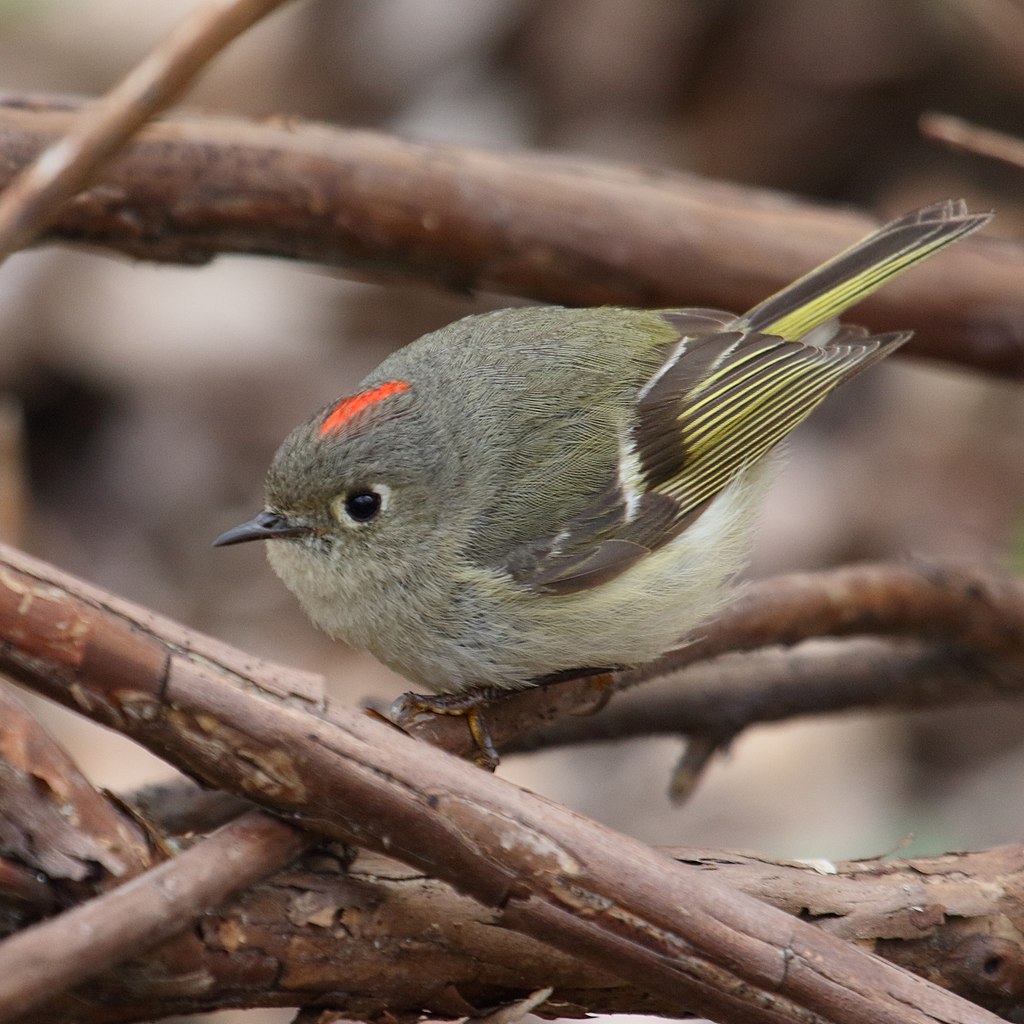
Coloration and Markings: Ruby-crowned Kinglets have soft gray backs and gray wings with some yellow-green coloration and 1 wingbar on each wing. They have a ‘dirty white’ breast and underbelly composed of gray and white coloration mixed and facially, They are white from the chin to just under the bill with most of the rest of the face being soft or darker gray and a small, vibrant red crest. This bird has a thick eyering and a medium-sized, thin and straight black bill.
Size: These birds measure in at 3.5 – 4.3 inches in length with wingspans of 6.3 to 7.1 inches.
Habitat: These birds favor coniferous and deciduous forests but they are happy to range forth when foraging in the winter, visiting parks and backyards to see what they can find. This is where you come in!
Diet: Berries and seeds are the way to go with this bird. Try some chopped cherries or strawberries and include a mix of Nyjer thistle and Black Oil Sunflower seeds on the side. These birds will love you for it.
Eastern Phoebe – Sayornis phoebe

Coloration and Markings: Eastern Phoebes have simple but beautiful coloration. They have brownish-gray backs, wings, and long tails, with some minor white highlighting in the wings. They have a snow-white breast and underbelly, with the white coloration continuing up to throat-level where it is also slightly visible just above the wings. Facially, they are a a light gray starting from the center of the eye and going down and a darker gray above. They have medium-sized, straight black bills.
Size: These birds measure in at 5.5 – 6.7 inches in length with wingspans of 10.2 to 11 inches.
Habitat: Eastern Phoebes feel safest in open areas, such as forest edges, fields, or parks. They will visit backyards as well, so be sure to leave a little something out for them.
Diet: These birds mostly eat insects but they do love the occasional berry as well. Elderberries are a favorite of theirs, so add these to your feeder and consider some dried mealworms and crickets.
Blue-headed Vireo – Vireo solitarius

Coloration and Markings: Blue-headed Vireos have delicate, lovely coloration. Their back and wings are a combination of gray and yellowish green, with 2 white wingbars on each wing and a medium-length tail of the same color as the wings, but with white edging. They have a snow-white breast and underbelly, with yellow-green flanking just under the wing and the white coloration continues up and thins snugly under the bill. From cheek level up, this bird is a light, grayish blue with white ‘spectacles’ present just in front of the medium-length, straight black bill.
Size: These birds measure in at 4.7 – 5.9 inches in length with wingspans of 8.7to 9.5 inches.
Habitat: These birds prefer montane and boreal forests but will sometimes range out when foraging.
Diet: These birds don’t visit feeders often, but they do like fruit. Try adding a mix of chopped apples and cherries to see if you can tempt a nearby Blue-headed Vireo.
Brown Creeper – Certhia americana
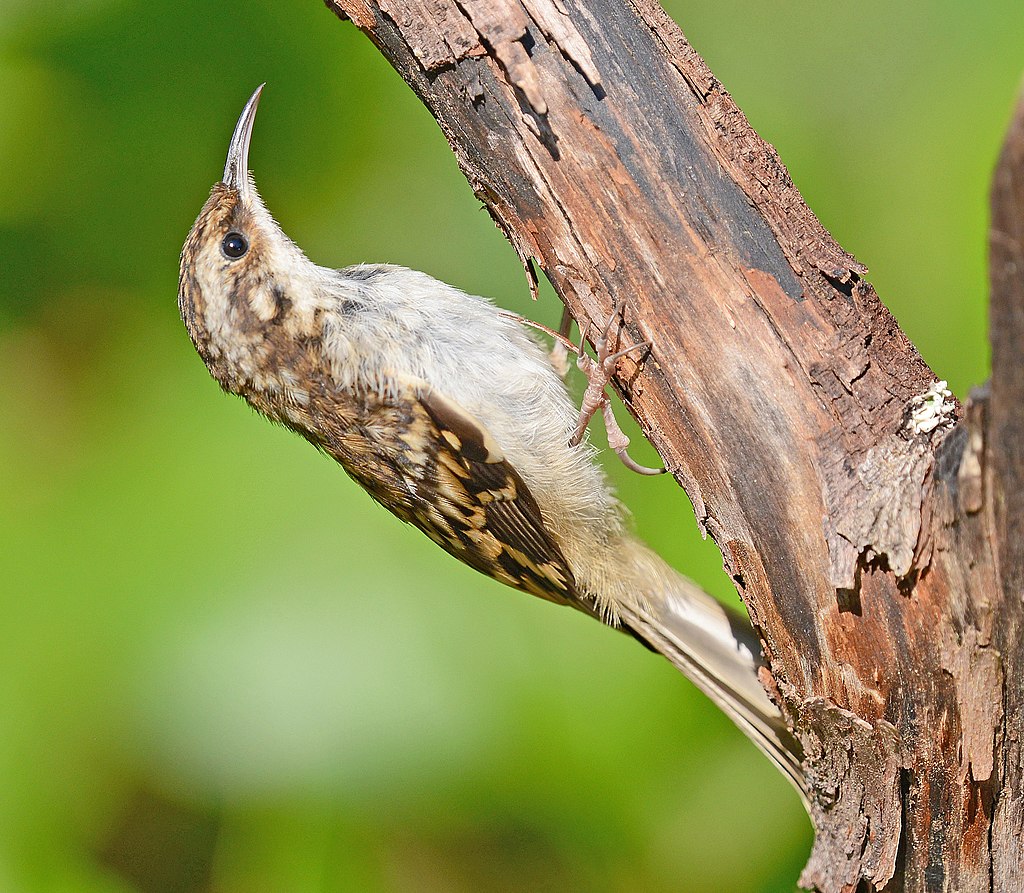
Coloration and Markings: Brown Creepers are pretty birds, with their brown backs and wings decorated with heavy white or buff streaking. Their long tails lack this streaking and their breast and underbelly are paper-white. This white extends up, ending at the bill and stretching horizontally to the cheeks. The rest of the face is the same brown and white/buff streaking and these birds have long, curved black bills.
Size: These little birds measure in at 4.7 – 5.5 inches in length with wingspans of 6.7 to 7.9 inches.
Habitat: When it’s warm these birds spend most of their time in deciduous or Evergreen forests, though winter gets them roaming and they soon end up in local parks and backyards.
Diet: These birds like Black Oil Sunflower seeds and corn but you’ll get the best results with suet and chunky peanut butter. These power-foods give a hungry bird that extra get-up-and-go in winter so be sure that these food items are present for best results.
Brown Thrasher – Toxostoma rufum
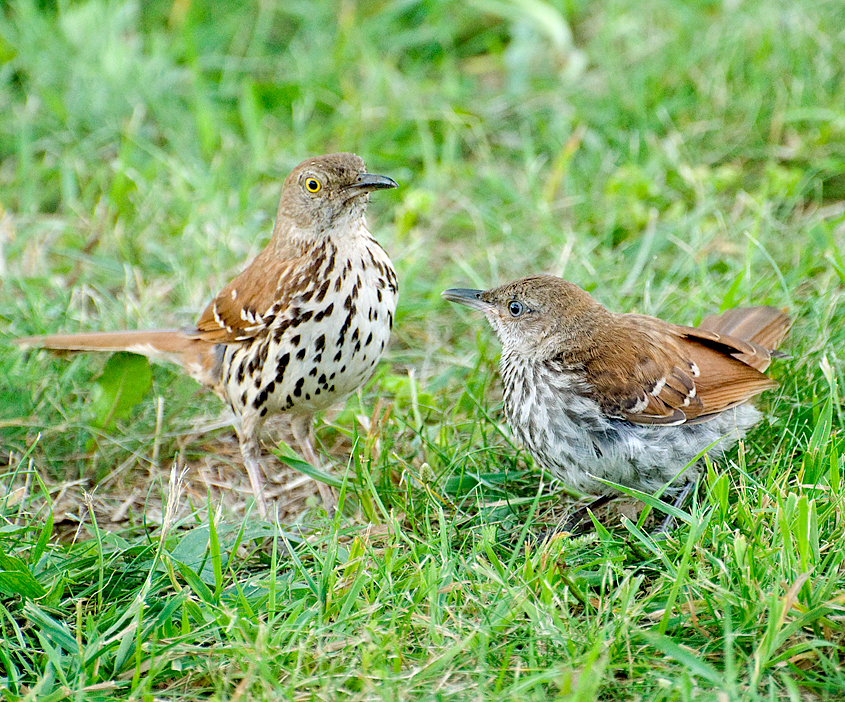
Coloration and Markings: The handsome Brown Thrasher is a rich brown color on its back, wings, and it’s long tail, with the exception being 2 black and white wingbars. The breast has brown and black streaks which become a light watercolor-brown color on the underbelly. Facially, from the throat to underneath the bill you’ll see white flanked with brown lines and this bird also has a white mustache line. Above the ‘mustache’ this bird has a mix of brown and white under and slightly over the bright yellow eyes with the top of the head being a creamy light brown. These birds have long, slightly curved black bills.
Size: These are good-sized birds, measuring in at 9.1 – 11.8 inches in length with wingspans of 11.4 to 12.6 inches.
Habitat: These birds love the forest’s edge and dense vegetation, which provides them cover when they are looking for insects or other snacks.
Diet: Brown Thrashes like a number of foods but some favorites include peanuts, fruits, Black Oil Sunflower seeds, and suet, especially.
Supporting Cast (Other Backyard Birds of South Carolina That Might Pay You a Visit)
While we provided some year-round birds we thought it would be nice to add an additional section where you have a few more birds who are out there, ready and waiting, to be spotted by you at any time of the year. While they didn’t get the fancy first-mention, this ‘supporting cast’ of birds are all stars on their own. Watch for these guys and gals in your backyard or the next time that you are out:
- Yellow-rumped Warbler
- Mourning Dove
- Eastern Bluebird
- House Finch
- Blue Jay
Yellow-rumped Warbler – Setophaga coronata

Coloration and Markings: Yellow-rumped Warblers have soft blue-gray backs and wings, with some black dotting accentuating the shoulders of the wings and vertical, white bands present at mid-wing level. They have long, gray tails which are black tipped with a breast of white with black dots making up a ‘vest’ which dwindles in density until becoming a snow-white underbelly. Distinctive yellow splotches are present under each wing and facially, this bird has a blue-gray face with a tiny, bright yellow bib and a white eyering curve present above and below (but not on the sides) of the eyes. These birds have medium-length, straight black bills. Females will show more muted colors, occasionally adding brown to their plumage, and in winter these birds are a dim brown with yellow coloration on the sides and the rump.
Size: These birds measure in at 4.7 – 5.5 inches in length with wingspans of 7.5 to 9.1 inches.
Habitat: When it’s warm these birds are most often found in coniferous or deciduous forests, though they will venture forth and can sometimes be seen in parks or the occasional backyard. This roaming is more active in the fall and winter but keep your eyes peeled, as these birds can be spotted year-round.
Diet: You can tempt a Yellow-rumped Warbler with raisins, chunky peanut butter, suet, and Black Oil Sunflower seeds. Add one or more of these to your feeder if you see one nearby and if it notices, then you might just make a new friend.
Mourning Dove – Zenaida macroura
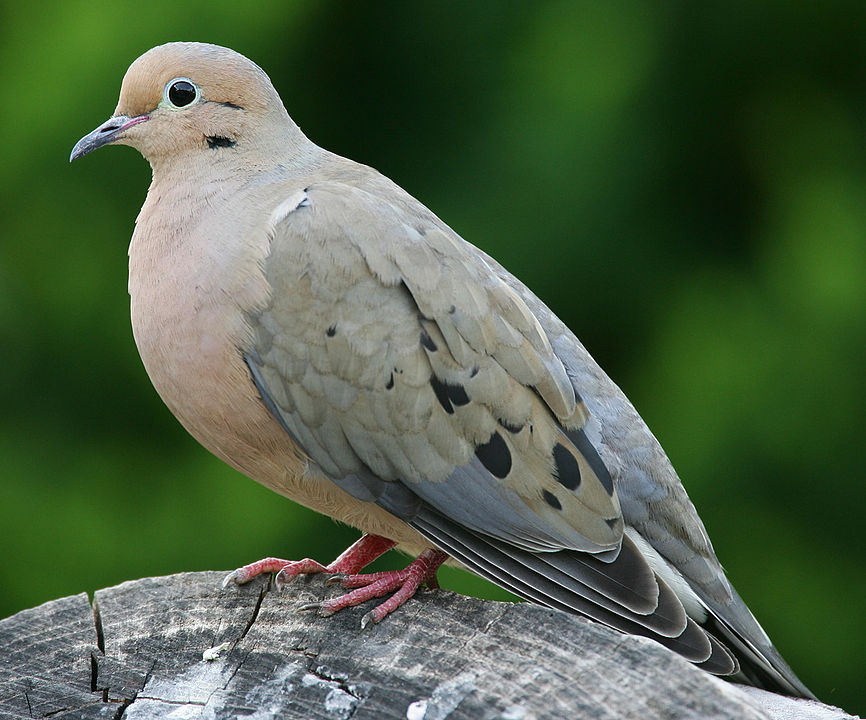
Coloration and Markings: The plump and pretty Mourning Dove has a gray back and wings, with a large concentration of creamy tan color on the wings as well as distinctive, large black spots. They have long gray tails and are creamy tan of breast, which lightens as the color approaches the underbelly. Facially, the tan coloration is the strongest and these birds have a thin, distinctive white eyering in front of a medium-sized, straight black bill.
Size: Roughly Robin-sized, these birds measure in at 9.1 – 13.4 inches in length with wingspans of approximately 17.7 inches.
Habitat: These birds like open areas, eschewing the deep forest areas for its edges and often simply moving on to parks and residential areas, where they are frequent visitors to bird-friendly backyards.
Diet: Black Oil Sunflower seeds and White Proso millet are an easy combination that may win you the affections of the Mourning Dove.
Eastern Bluebird – Sialia sialis
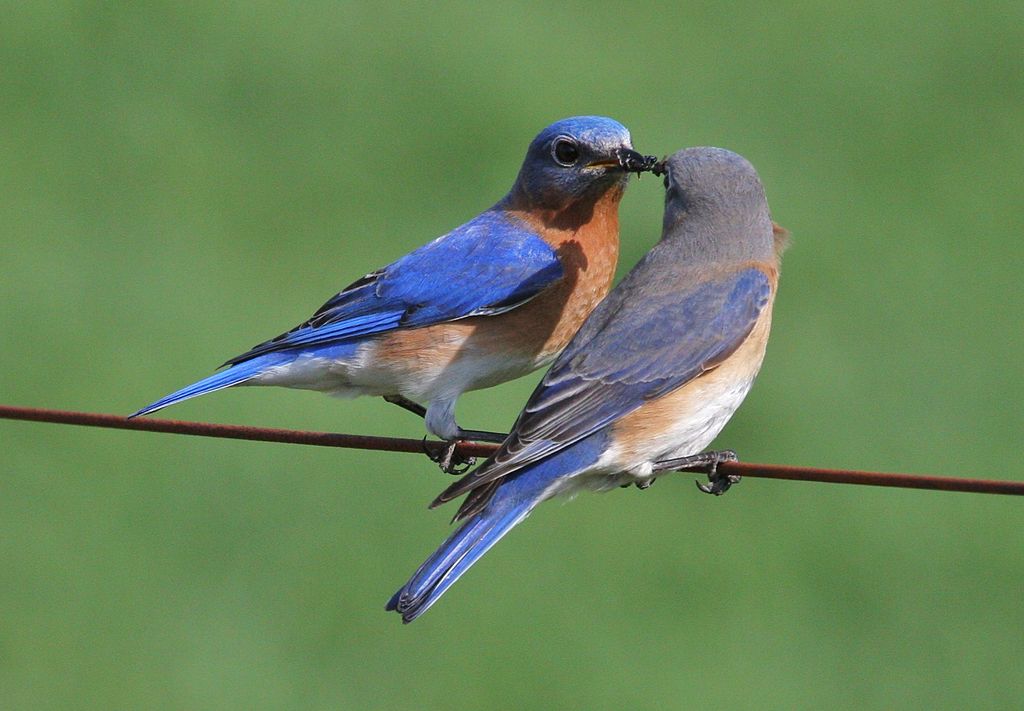
Coloration and Markings: Eastern Bluebirds have lovely coloration, with blue backs and blue black-tipped wings. They have small, blue tails and orange brown-to-red breast and throat (with the coloration at the throat carrying on until the back of the head). The underbelly and rump of this bird are white and facially, this bird has a blue face from the cheeks up and a medium-sized, slightly curved gray bill.
Size: These birds measure in at 6.3 – 8.3 inches in length with wingspans of approximately 9.8 to 12.6 inches.
Habitat: These birds prefer open areas, such as parks, fields, or meadows. Residentially, they also visit parks, golf courses, and backyards provided that they are fairly open so that the bird feels safe.
Diet: Eastern Bluebirds are a little shy about visiting feeders, however, you can often get good results by adding dried mealworms and crickets to your feeder.
House Finch – Haemorhous mexicanus
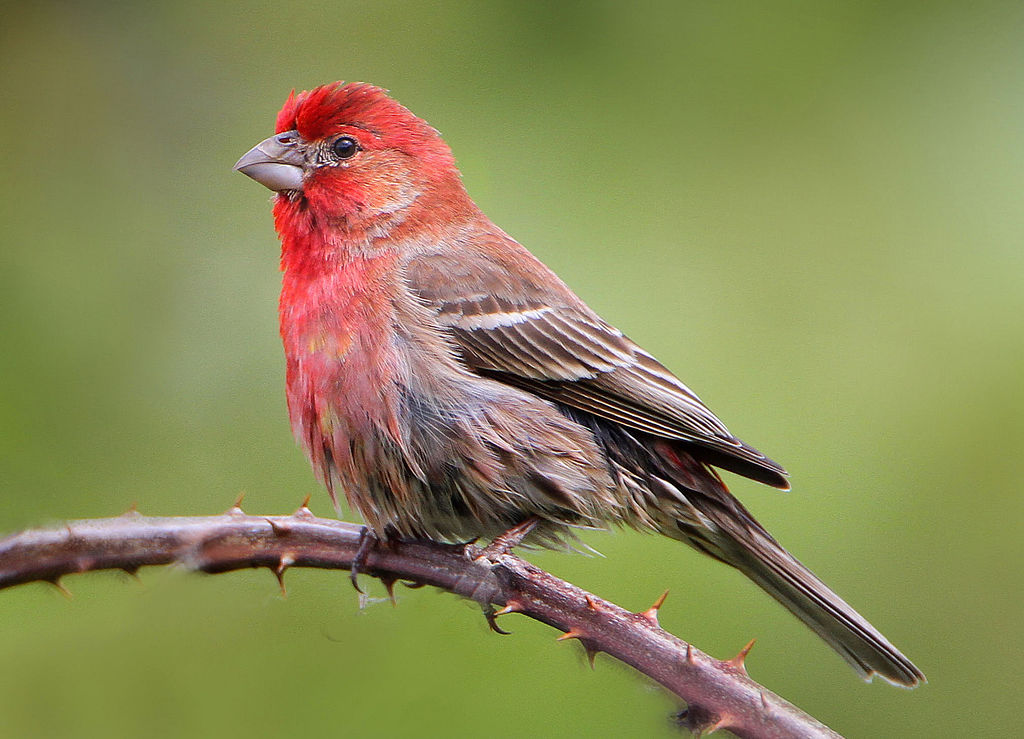
Coloration and Markings: The House Finch has a gray back and wings which are gray with vertical black lines with horizontal white lines underscoring them. They have long, gray tails with some white on the outer feathers and their breast is white with a saturation of rosy-red hues. This becomes a faint streaking as the coloration approaches the underbelly and facially, these birds have rosy red heads with the occasional zigzagging of gray behind the eye and some gray skin around it. These birds have stout, curved silver bills. Females have a different coloration, with no rosy-red present but rather gray and brown plumage with some thick streaking.
Size: These birds measure in at 5.1 – 5.5 inches in length with wingspans of 7.9 to 9.8 inches.
Habitat: When they are not spending time at the forest’s edge, these birds are highly urbanized, frequenting parks, farms, backyards, or simply scouting the area from telephone wires. They are not shy about inhabited areas and will happily visit a stocked feeder.
Diet: House Finches will eat many things but the easiest lure at your disposal is to simply add Black Oil Sunflower seeds, either small or broken, into your feeder. These little guys love it.
Blue Jay – Cyanocitta cristata
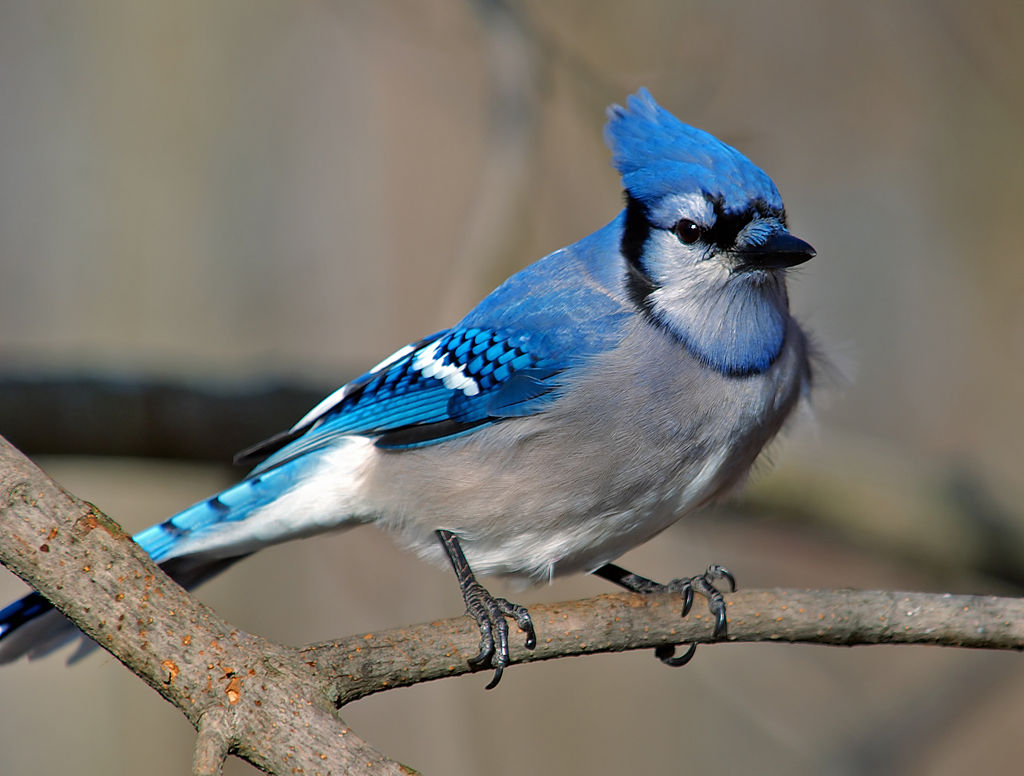
Coloration and Markings: Blue Jays are stunning, with blue backs and wings, with the wings displaying white wingbars and white patches outlined in black. The tails tend to have symmetrical light-blue squares on the deeper blue whole. They have white breast and underbelly and facially, the head is ringed with a black line that starts up from its majestic blue crest, working around the throat to the other side. The rest of the face is white with the exception of it’s thin mask, which branches a bit under and between the eyes in an abstract fashion. This bird has a long, straight black bill.
Size: Roughly Robin-sized, these birds measure in at 9.8 – 11.8 inches in length with wingspans of 13.4 to 16.9 inches.
Habitat: Blue Jays frequent the forest’s edge as well as just about everywhere in cities and towns. Not shy of inhabited areas, if you see a Blue Jay nearby be sure to stock your feeder quickly and you might just get their attentions.
Diet: These birds mostly eat acorns, seeds, and nuts, so a simply lure for Blue Jays is a mix of peanuts and Black Oil Sunflower seeds. Give it a try and watch what happens!
South Carolina Bird Buffet
If you’d like to make a feeder setup with a selection designed to attract the most birds then we have a little advice to give you from ourselves as well as SouthCarolinaBirds.com. There are some basic items which you can add to your feeder that will get great results, so try adding the following foodstuffs:
- Black Oil Sunflower
- Nyjer thistle
- Safllower
- Suet
- Chunky peanut butter
- Peanuts
- White Proso millet
South Carolina Birding Hot spots
There are a number of great places to see birds in the state of South Carolina and the Chirparazzi know ALL of them. They’ve got a few recommendations for you if you are looking to get a glimpse of or photo the local Aerial celebrities. These locations are centered around the compass points so that you can find somewhere which is conveniently located but don’t worry if these sites are too far, as we will include a reference link that will help you to find others if the ones that we have provided do not suffice. Visit one or more of these locations when you get a chance for a great day of birding:
- Northern hotspot – Palmetto Trail (Peak to Prosperity Passage)
- Eastern hotspot – Savannah Valley Railroad Trail
- Southern hotspot – New River Linear Trail
- Western hotspot – Savannah Valley Railroad Trail
- Central hotspot – Williston Rail-Trail
Detailed descriptions of each location as well as information regarding visiting and what birds you can see at these locations may be found at https://www.traillink.com/stateactivity/sc-birding-trails/
Final Thoughts
Well, that is all the time that we have for today but we hope that you have enjoyed this exploration of the Avian wonders of South Carolina. If you aren’t a local, this is a state well-worth visiting for a birding holiday so keep that trail link handy and if you feel wild one weekend, why not visit?
As for the locals, keep your eyes peeled and those feeders well-stocked and we have a feeling that your backyard will have many a beautiful, winged visitor. Until next time we wish you happy birding!
